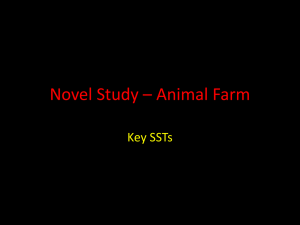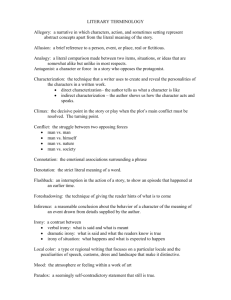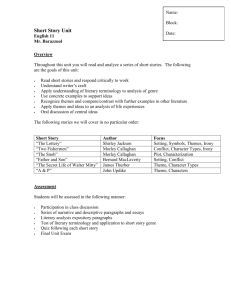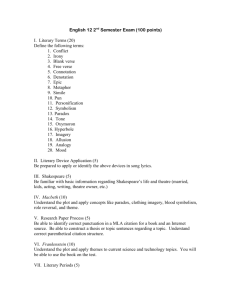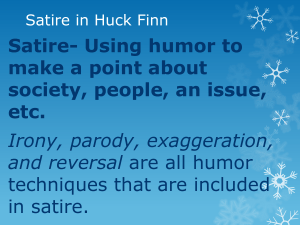Literary Terms for English 11 Honors
advertisement
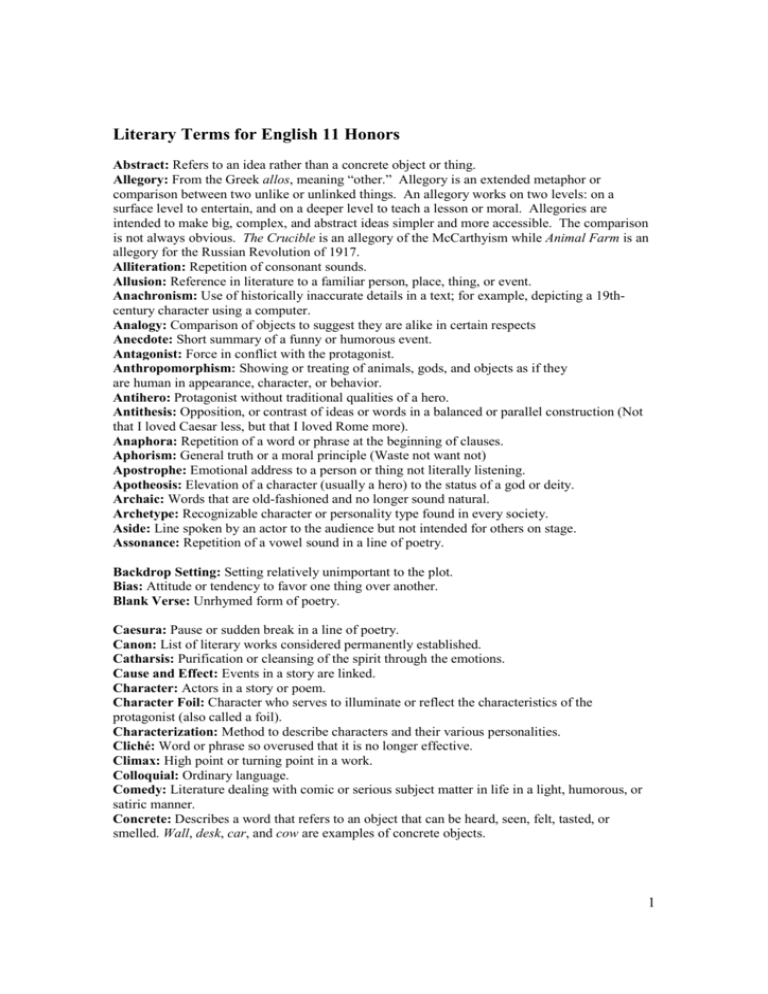
Literary Terms for English 11 Honors Abstract: Refers to an idea rather than a concrete object or thing. Allegory: From the Greek allos, meaning “other.” Allegory is an extended metaphor or comparison between two unlike or unlinked things. An allegory works on two levels: on a surface level to entertain, and on a deeper level to teach a lesson or moral. Allegories are intended to make big, complex, and abstract ideas simpler and more accessible. The comparison is not always obvious. The Crucible is an allegory of the McCarthyism while Animal Farm is an allegory for the Russian Revolution of 1917. Alliteration: Repetition of consonant sounds. Allusion: Reference in literature to a familiar person, place, thing, or event. Anachronism: Use of historically inaccurate details in a text; for example, depicting a 19thcentury character using a computer. Analogy: Comparison of objects to suggest they are alike in certain respects Anecdote: Short summary of a funny or humorous event. Antagonist: Force in conflict with the protagonist. Anthropomorphism: Showing or treating of animals, gods, and objects as if they are human in appearance, character, or behavior. Antihero: Protagonist without traditional qualities of a hero. Antithesis: Opposition, or contrast of ideas or words in a balanced or parallel construction (Not that I loved Caesar less, but that I loved Rome more). Anaphora: Repetition of a word or phrase at the beginning of clauses. Aphorism: General truth or a moral principle (Waste not want not) Apostrophe: Emotional address to a person or thing not literally listening. Apotheosis: Elevation of a character (usually a hero) to the status of a god or deity. Archaic: Words that are old-fashioned and no longer sound natural. Archetype: Recognizable character or personality type found in every society. Aside: Line spoken by an actor to the audience but not intended for others on stage. Assonance: Repetition of a vowel sound in a line of poetry. Backdrop Setting: Setting relatively unimportant to the plot. Bias: Attitude or tendency to favor one thing over another. Blank Verse: Unrhymed form of poetry. Caesura: Pause or sudden break in a line of poetry. Canon: List of literary works considered permanently established. Catharsis: Purification or cleansing of the spirit through the emotions. Cause and Effect: Events in a story are linked. Character: Actors in a story or poem. Character Foil: Character who serves to illuminate or reflect the characteristics of the protagonist (also called a foil). Characterization: Method to describe characters and their various personalities. Cliché: Word or phrase so overused that it is no longer effective. Climax: High point or turning point in a work. Colloquial: Ordinary language. Comedy: Literature dealing with comic or serious subject matter in life in a light, humorous, or satiric manner. Concrete: Describes a word that refers to an object that can be heard, seen, felt, tasted, or smelled. Wall, desk, car, and cow are examples of concrete objects. 1 Conflict: Struggle between the protagonist and an opposing force; the “problem” in a story that triggers the action. Conflict is divided by internal conflict and external conflict. There are five basic types of external conflict: • Man vs. Man: One character in a story has a problem with one or more of the other characters. • Man vs. Society: A character has a conflict or problem with some element of society—the school, the law, the accepted way of doing things, and so on. • Man vs. Himself: A character has trouble deciding what to do in a particular situation. • Man vs. Nature: A character has a problem with some natural happening: a snowstorm, an avalanche, the bitter cold, or any of the common elements of nature. • Man vs. Fate (God): A character has to battle what seems to be an uncontrollable problem. Whenever the problem seems to be a strange or unbelievable coincidence, fate can be considered as the cause of the conflict. Connotation: Emotions or feelings a word can arouse. Context: Environment of a word. Convention: Customary feature of a literary work, such as the use of a chorus in Greek tragedy, the inclusion of an explicit moral in a fable, or the use of a couplet at the end of a sonnet. Crisis: Moment when a character faces a harsh situation and must make a decision. Denotation: Literal or dictionary meaning of a word. Dialogue: Conversation by the characters. Diction: Author's choice of words. Direct Characterization: Author explicitly tells the reader about the character (She is dumb). Doppelganger: Ghostly counterpart of a living person or an alter ego. Drama: Plays Dramatic Irony: A character speaks in ignorance of a situation or event known to the audience or to the other characters. Dynamic Character: Character who is altered at the end of the story. Elegy: Poem mourning the death of a person. Epic: Long poem. Epigraph: Short saying at the beginning of a book or chapter that suggests its theme. Epiphany: Sudden or intuitive insight or perception into the reality or essential meaning of something usually brought on by a simple or common occurrence or experience. Epistolary: Literature contained in or carried on by letters. Epitaph: Writing that praises a deceased person. Epithet: Adjective or descriptive phrase expressing a characteristic of the person or thing mentioned. (e.g., mother of dragons, king slayer, the imp) Ethos: Greek root meaning character. It is usually an appeal to the credibility of the speaker or author. A work with ethos is convincing, the audience trusts, respects, and admires the speaker. Eulogy: Oration in honor of a deceased person. Euphemism: Substitution of an agreeable or at least non-offensive expression for a plainer possibly harsher or unpleasant meaning (pre-owned for used; temporary negative cash flow for broke, enhanced interrogation methods for torture). Exposition: How things are before the action of a story starts. External Conflict: Conflict that exists outside the character. Falling Action: Action that occurs after the climax. Fiction: Imagined story, whether in prose, poetry, or drama. 2 Figurative Language: Form of language use in which writers and speakers convey something other than the literal meaning of their words. First Person: Point of view in a work that relies on first-person pronouns like I, me, we, etc. Flashback: Interruption of a work's chronology to describe or present an incident that occurred prior to the main time frame of a work's action. Flat Character: Character who is never fully developed or lacking a sense of depth. Foreshadowing: Hints of what is to come in the action of a play or a story. Frame Story: A story told within a story. Free Verse: Poetry that does not have a regular meter or rhyme scheme. Genre: Specific type or subtype of music, film, or writing. Your favorite literary genre might be science fiction, your favorite film genre might be horror, and you favorite music genre might be indie rock. Gothic: Genre of fiction characterized by mystery and supernatural horror, often set in a dark castle or other medieval setting. Edgar Allan Poe is considered the master of the genre. Hyperbole: Exaggerated statement or claim (big as a house, I could eat a horse). Imagery: Use of expressive or evocative images in art, literature, or music. In medias res: Type of narrative timeline that opens the work in the middle of the action Indirect Characterization: Author suggests character qualities rather than directly stating them (She was fired from the M&M factory for throwing away all the W’s = she’s dumb). Integral Setting: Setting that is essential to the plot. Internal Conflict: Conflict a person experiences within himself or herself. Internal Rhyme: Rhyming words appear within the same line of poetry. Irony: Contrast or discrepancy between what is said and what is meant or between what happens and what is expected to happen in life and in literature. The opposite of what is expected. Juxtaposition: Placing ideas, characters, settings, or objects side-by-side for emphasis Literary Elements: The building blocks of story. These include plot, character, setting, point of view and theme. Logos: Appeal to logic and reasoning. The speaker or writer intends to make the audience think clearly about the sensible and/or obvious answer to a problem. Metaphor: Comparison of two unlike objects to show a likeness between them. Motif: Any reoccurring character, incident, idea, or structure. Mood: Overall feeling or emotional atmosphere of a story. Myth: Any story that attempts to explain how the world was created or why the world is the way that it is. Onomatopoeia: Word whose sound suggests its meaning, as in clang, buzz,, and twang. Oxymoron: Figure of speech that combines two contradictory elements, as in "jumbo shrimp" or "deafening silence." Paradox: Statement that at first seems contradictory but turns out to have a profound meaning Parallelism: Framing of words, phrases, sentences, or paragraphs to give structural similarity. Parody: Imitation with the aim of amusing the audience. Pathos: Greek root meaning suffering or passion. It is usually an appeal to the emotions of the reader. 3 Persona: In literature, the persona is the narrator, or the storyteller, of a literary work created by the author. The persona is not the author, but the author’s creation—the voice “through which the author speaks.” It could be a character in the work, or a fabricated onlooker, relaying the sequence of events in a narrative. Personification: Giving human attributes to a non-human creature or thing. Plot: Action in a story. It is usually a series of related events that builds and grows as the story develops. Plot consists of exposition, rising action, climax, falling action and resolution. Point of View: Perspective from which a story is told. It consists of first person, second person, third person objective, third person limited, and third person omniscient. Poetic Devices: Tools an author uses to create the images, meanings, sounds and feelings that move language beyond the literal. Poetic devices are often divided into cognitive devices (those that create meaning) and sound or auditory devices (those that create rhythm and sound). Poetry: Language that reflects imagination, emotion, and thinking in verse form. Prose: Ordinary form of written language without metrical structure. Protagonist: Main character or lead figure in a novel, play, story, or poem. Pun: Joke exploiting the different possible meanings of a word or the fact that there are words that sound alike but have different meanings. Repetition: Repeating of a word or idea for emphasis. Resolution: The way a story ends, with all the loose ends are tied up. Rhetoric: Art of effective or persuasive speaking or writing. Rhetorical Question: Question that has no expectation of a reply. Who knew? Rising Action: Sequence of conflicts and crises that lead to a climax. Round Character: Character who is fully developed and appears to have a variety of realistic character attributes. Satire: Like parody, satire conveys humor but their goals are different. Parody aims to entertain while satire often results in political or social change. Parody leaves the observer amused, while satire may leave the observer with a variety of emotions such as scorn, indignation, and also amusement. Parody imitates its object, while satire derogates the object, making it appear ridiculous. Satire makes a serious point through humor, exposing the flaws, hypocrisy or fallacies of the object of ridicule. It uses humor as a weapon. The Colbert Report and The Daily Show are prime examples of satire. Science Fiction: Futuristic technology or otherwise altered scientific principles contribute in a significant way to the adventures. Second Person: Point of view that employs a conversational convention, often through the use of the pronoun “you.” Setting: Total environment for the action of a fictional work. Setting includes time period (such as the 1890's), the weather, the place (such as downtown Warsaw), the historical milieu (such as during the Crimean War), as well as the social, political, and perhaps even spiritual realities. Simile: Comparison of two unlike objects using “like” or “as.” Situational Irony: Sometimes called irony of events, is most broadly defined as a situation where the outcome is incongruous with what was expected, but it is also more generally understood as a situation that includes contradictions or sharp contrasts. (A fireman’s house catches on fire; a psychiatrist is crazy). Soliloquy: Dramatic speech; character does not address any of the other characters. Static Character: Character who does not change over the course of the story. Style: Author’s distinctive voice; the manner of expression of a particular writer, produced by choice of words, grammatical structures, use of literary devices, and all the possible parts of language use. Subplot: Subordinate or minor collection of events in a novel or drama. 4 Syllogism: Form of reasoning in which a conclusion is drawn from two premises, each of which shares a term with the conclusion, and shares a common or middle term not present in the conclusion (e.g., all dogs are animals; all animals have four legs; therefore all dogs have four legs ). Symbol: Object that represents or stands for something else, especially a material object representing something abstract (a flag represents patriotism; a cross represents Christianity). Synecdoche: Figure of speech in which a part is made to represent the whole For example, calling a car “wheels”, calling food “bread”, or referring to a ship as merely “sails”. Syntax: Way an author chooses to join words into phrases, clauses, and sentences. Syntax is similar to diction, but you can differentiate them by thinking of syntax as the groups of words, while diction refers to the individual words. Theme: Message or reoccurring idea of a literary work; the universal truth of a story. Third Person Limited: When the story is seen through the eyes of one particular character. The narrator reveals only one character’s inner thoughts. Third Person Objective: When the author uses “he” or “she” to refer to the character. The author states only what can be seen; not what’s in characters’ minds. Called the camera eye. Third Person Omniscient: When the story is told through the point of view of an all-knowing (i.e., omniscient) narrator who supplies more information about all of the characters and events than any one character could know. The narrator knows the thoughts and feelings of all the characters. Tone: Writer's attitude toward the work. A writer can be formal, informal, playful, ironic, and especially, optimistic or pessimistic. Tragedy: Broadly defined, a literary and particularly a dramatic presentation of serious actions in which the chief character has a disastrous fate. Tricolon: Series of three parallel words, phrases, or clauses. (Of the people, for the people, by the people). Understatement: Ironic minimizing of fact, understatement presents something as less significant than it is. The effect can frequently be humorous and emphatic. Understatement is the opposite of hyperbole. Unreliable Narrator: Narrator whose credibility has been seriously compromised. The reader must wade through evidence to form his/her own sense of reality or truth rather than believing a novel’s narrator. Verbal Irony: Characters say the opposite of what they mean. Verisimilitude: Verisimilitude refers to the resemblance a work bears to reality. If a work of literature has verisimilitude, it has a certain likeness to actual life. 5

